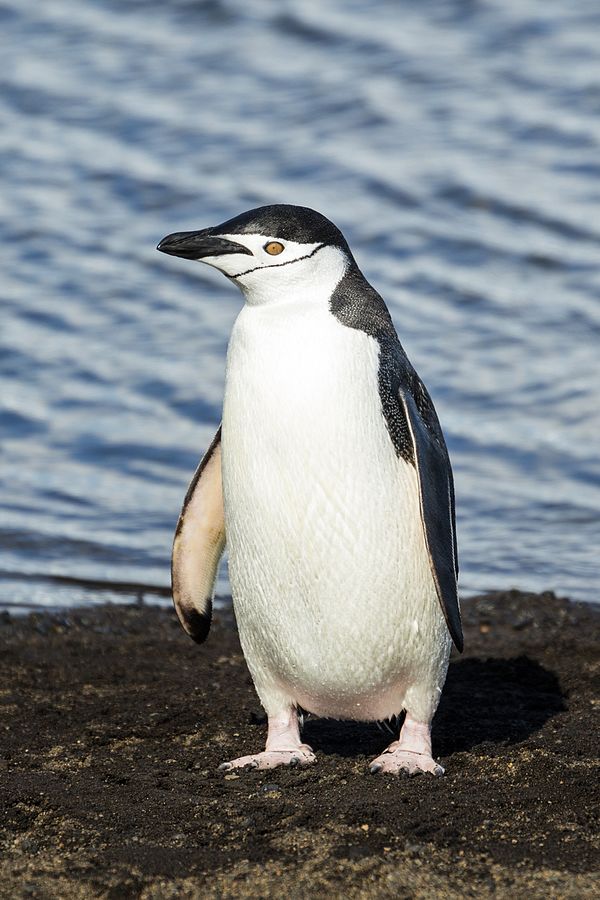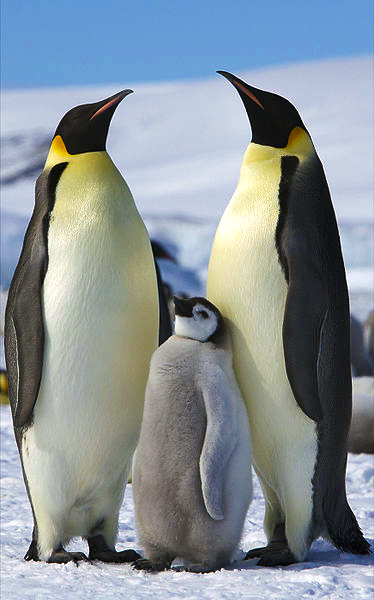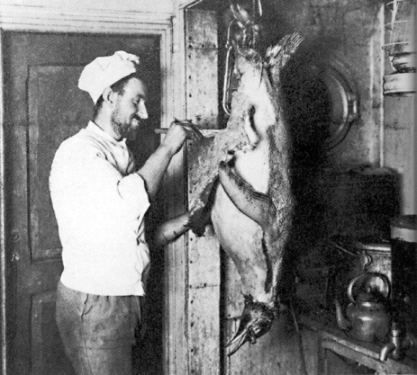Penguin
Penguins (order Sphenisciformes, family Spheniscidae) are a group of aquatic, flightless birds. Highly adapted for life in the water, penguins have countershaded dark and white plumage, and their wings have evolved into flippers. Most penguins feed on krill, fish, squid and other forms of sea life caught while swimming underwater. They spend about half of their lives on land and half in the oceans.
Although almost all penguin species are native to the Southern Hemisphere, they are not found only in cold climates, such as Antarctica. In fact, only a few species of penguin live so far south. Several species are found in the temperate zone, and one species, the Galápagos penguin, lives near the equator.
The largest living species is the emperor penguin (Aptenodytes forsteri): on average, adults are about 1.1 m (3 ft 7 in) tall and weigh 35 kg (77 lb). The smallest penguin species is the little blue penguin (Eudyptula minor), also known as the fairy penguin, which stands around 40 cm (16 in) tall and weighs 1 kg (2.2 lb). Among extant penguins, larger penguins inhabit colder regions, while smaller penguins are generally found in temperate or even tropical climates (see also Bergmann's rule). Some prehistoric species attained enormous sizes, becoming as tall or as heavy as an adult human. These were not restricted to Antarctic regions; on the contrary, subantarctic regions harbored high diversity, and at least one giant penguin occurred in a region around 2,000 km south of the equator 35 mya, in a climate decidedly warmer than today.
Living species
- Aptenodytes – great penguins
- Pygoscelis – brush-tailed penguins
- Eudyptula – little penguins
- Little blue penguin
- Australian little penguin
- White-flippered penguin
- Spheniscus – banded penguins
- Magellanic penguin
- Humboldt penguin
- Galapagos penguin
- African penguin
- Megadyptes
- Yellow-eyed penguin
- Eudyptes – crested penguins
- Fiordland penguin
- Snares penguin
- Erect-crested penguin
- Western rockhopper penguin
- Eastern rockhopper penguin
- Northern rockhopper penguin
- Royal penguin (disputed)
- Macaroni penguin
Evolution
The evolutionary history of penguins is well-researched and represents a showcase of evolutionary biogeography; though as penguin bones of any one species vary much in size and few good specimens are known, the alpha taxonomy of many prehistoric forms still leaves much to be desired. Some seminal articles about penguin prehistory have been published since 2005; the evolution of the living genera can be considered resolved by now.
The basal penguins lived around the time of the Cretaceous–Paleogene extinction event somewhere in the general area of (southern) New Zealand and Byrd Land, Antarctica. Due to plate tectonics, these areas were at that time less than 1,500 kilometres (930 mi) apart rather than the 4,000 kilometers (2,500 mi) of today. The most recent common ancestor of penguins and their sister clade can be roughly dated to the Campanian–Maastrichtian boundary, around 70–68 mya. What can be said as certainly as possible in the absence of direct (i.e., fossil) evidence is that, by the end of the Cretaceous, the penguin lineage must have been evolutionarily well distinct, though much less so morphologically; it is fairly likely that they were not yet entirely flightless at that time, as flightless birds have generally low resilience to the breakdown of trophic webs that follows the initial phase of mass extinctions because of their below-average dispersal capabilities
Penguins and humans
Penguins seem to have no special fear of humans, and have approached groups of explorers without hesitation. This is probably because penguins have no land predators in Antarctica or the nearby offshore islands. Dogs preyed upon penguins while they were allowed in Antarctica during the age of early human exploration as sled dogs, but dogs are now banned from Antarctica. Instead, adult penguins are at risk at sea from predators such as sharks, the orca, and the leopard seal. Typically, penguins do not approach closer than about 3 meters (9.8 feet) at which point they become nervous. This is also the distance that Antarctic tourists are instructed to maintain between themselves and penguins: tourists are instructed not to approach closer than 3 meters, but need not withdraw if the penguins come closer.
In June 2011, a penguin came ashore on New Zealand's Peka Peka Beach, 3200 km off course on its journey to Antarctica. Nicknamed Happy Feet, after the movie of the same name, it was suffering from heat exhaustion and had to undergo a number of operations to remove objects like driftwood and sand from its stomach. Happy Feet was a media sensation, with extensive coverage on TV and the web, including a live stream that had thousands of views and a visit from English actor Stephen Fry. Once he had recovered, Happy Feet was released back into the water south of New Zealand.
In the mid-2000s, penguins became one of the most publicized species of animals that form lasting homosexual couples. A children's book, And Tango Makes Three, was written about one such penguin family in the New York Zoo.


